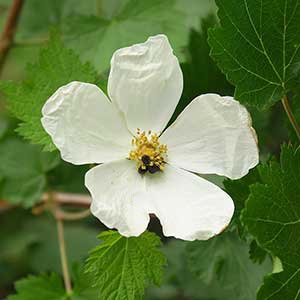Rubus bartonianus
Rubus chamaemorus
Barton's raspberry, bartonberry
baked-apple-berry, chicouté, cloudberry, plaquebière
erect, sparsely short-hairy, glabrescent, eglandular, not pruinose.
from rhizomes, erect, rarely woody basally, sparsely hairy, sparsely stipitate-glandular distally, not pruinose.
deciduous, simple;
stipules lanceolate, 4–6 mm;
blade cordate to broadly ovate, (2–)2.5–4(–5) × (2.5–)3.5–4.5(–5.5) cm, base deeply cordate, 3–5-lobed, lobe apices acute to obtuse, margins coarsely doubly dentate, abaxial surfaces glabrous or sparsely hairy, eglandular or sparsely stipitate-glandular.
deciduous, simple;
stipules broadly ovate to oblong, 3–6 mm;
blade reniform or orbiculate, 2.5–6 × (3–)5–8(–12) cm, base cordate, 3–7-lobed, lobe apices rounded, margins finely doubly serrate or dentate, abaxial surfaces sparsely hairy, sparsely to moderately stipitate-glandular along veins.
1-flowered.
1-flowered.
moderately hairy, eglandular or sparsely stipitate-glandular.
pubescent, sparsely to densely short- to long-stipitate-glandular.
bisexual;
petals white, obovate, (15–)20–25 mm;
filaments filiform;
ovaries glabrous, styles clavate, villous.
unisexual;
petals white, obovate, (8–)10–15(–18) mm;
filaments filiform;
ovaries glabrous, styles filiform, glabrous.
deep red, hemispheric, to 1 cm;
drupelets 10–30, coherent, separating from torus.
golden yellow to orange or reddish, globose, 1.2–1.5 cm;
drupelets (5–)10–20, moderately coherent, separating from torus.
= 56.
Rubus bartonianus
Rubus chamaemorus
Of conservation concern.
Rubus bartonianus is distinguished from the other flowering raspberries within its geographic range by its erect, unarmed stems, relatively small, simple leaves with acute to obtuse lobes, deeply cordate bases, sparsely hairy or glabrous abaxial surfaces, relatively large flowers with white petals, and densely long-hairy, clavate styles. The leaves superficially resemble those of Acer glabrum or some species of Ribes.
Rubus bartonianus is most similar to R. neomexicanus but especially R. deliciosus. The species is known only from the Snake River Canyon of Idaho and Oregon.
(Discussion copyrighted by Flora of North America; reprinted with permission.)
Rubus chamaemorus is circumboreal; it is presumed to be extirpated from New York, where it was known only from a single population on Long Island, far removed from the next southernmost localities in northern New Hampshire.
Rubus chamaemorus is defined by its unarmed stems, simple, coriaceous, and plicate leaves, unisexual flowers, and golden yellow to reddish fruits. Rubus chamaemorus is likely an ancient allopolyploid (K. V. Ambrose 2006).
The edible fruits of Rubus chamaemorus are highly valued in northern regions for consumption fresh and in yogurt, jams, syrups, and juices. An alcoholic beverage is made from the fruits and sold commercially in Newfoundland, Quebec, and Finland.
(Discussion copyrighted by Flora of North America; reprinted with permission.)


